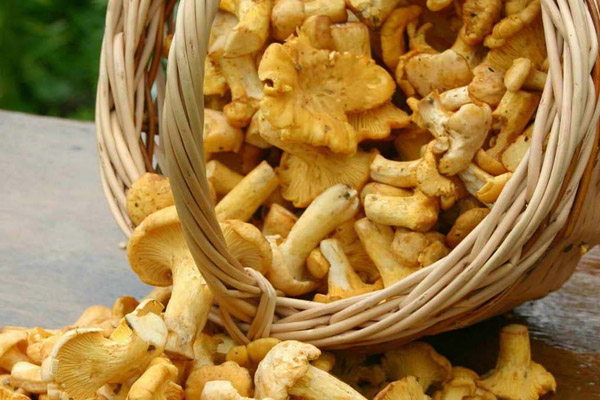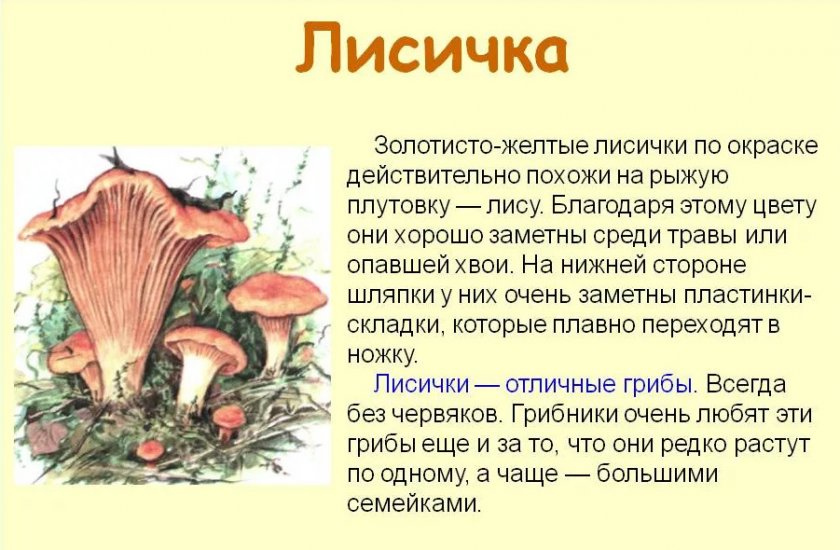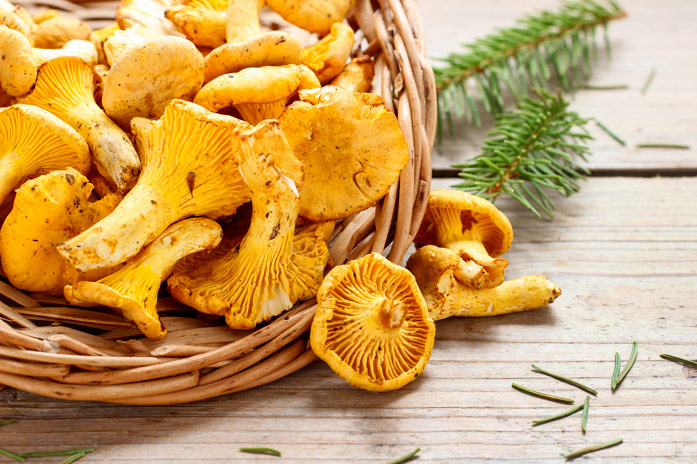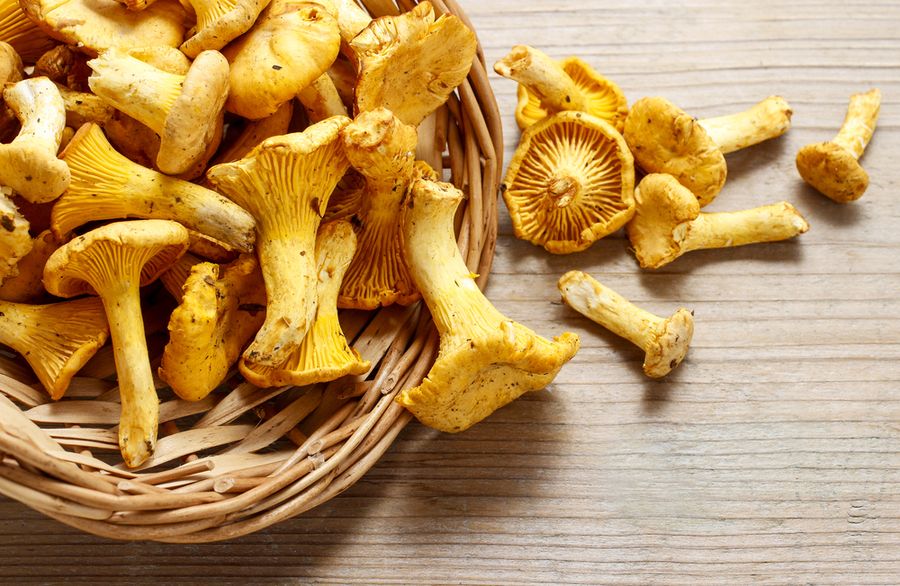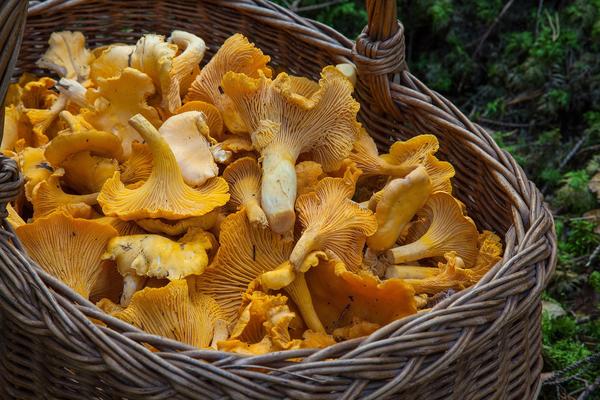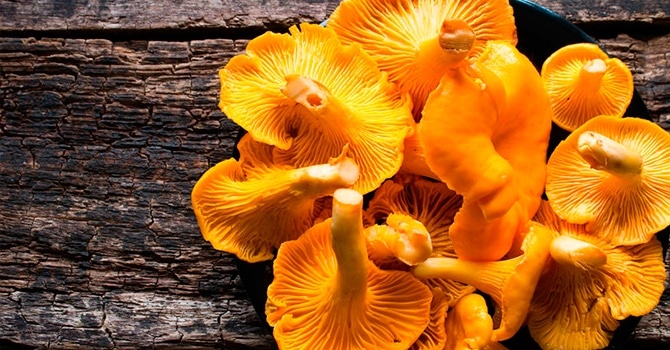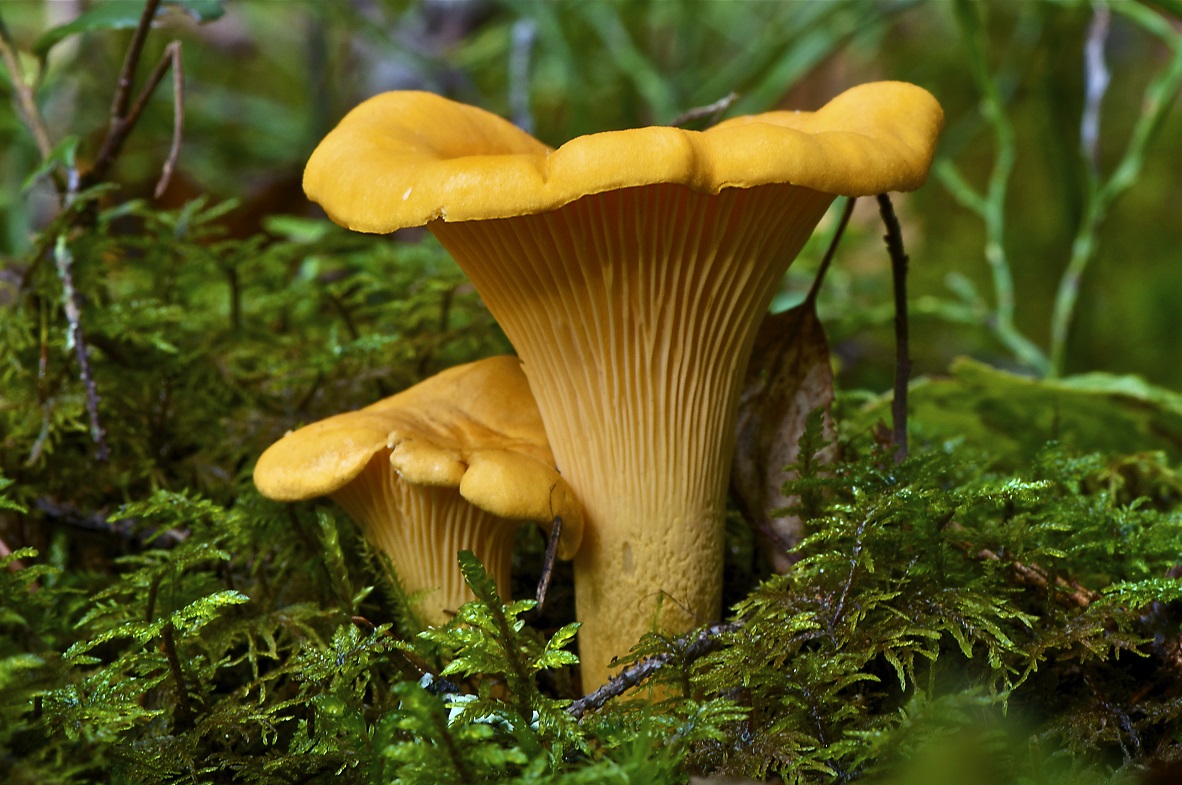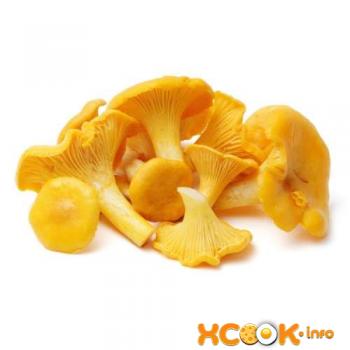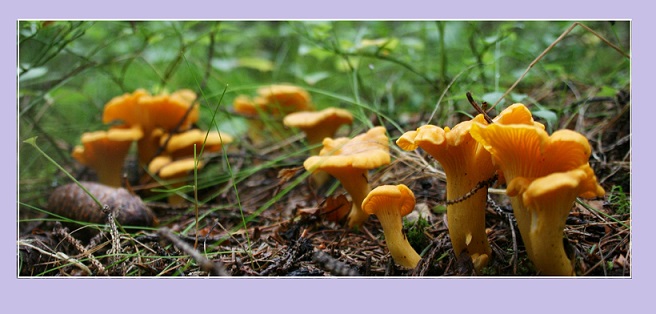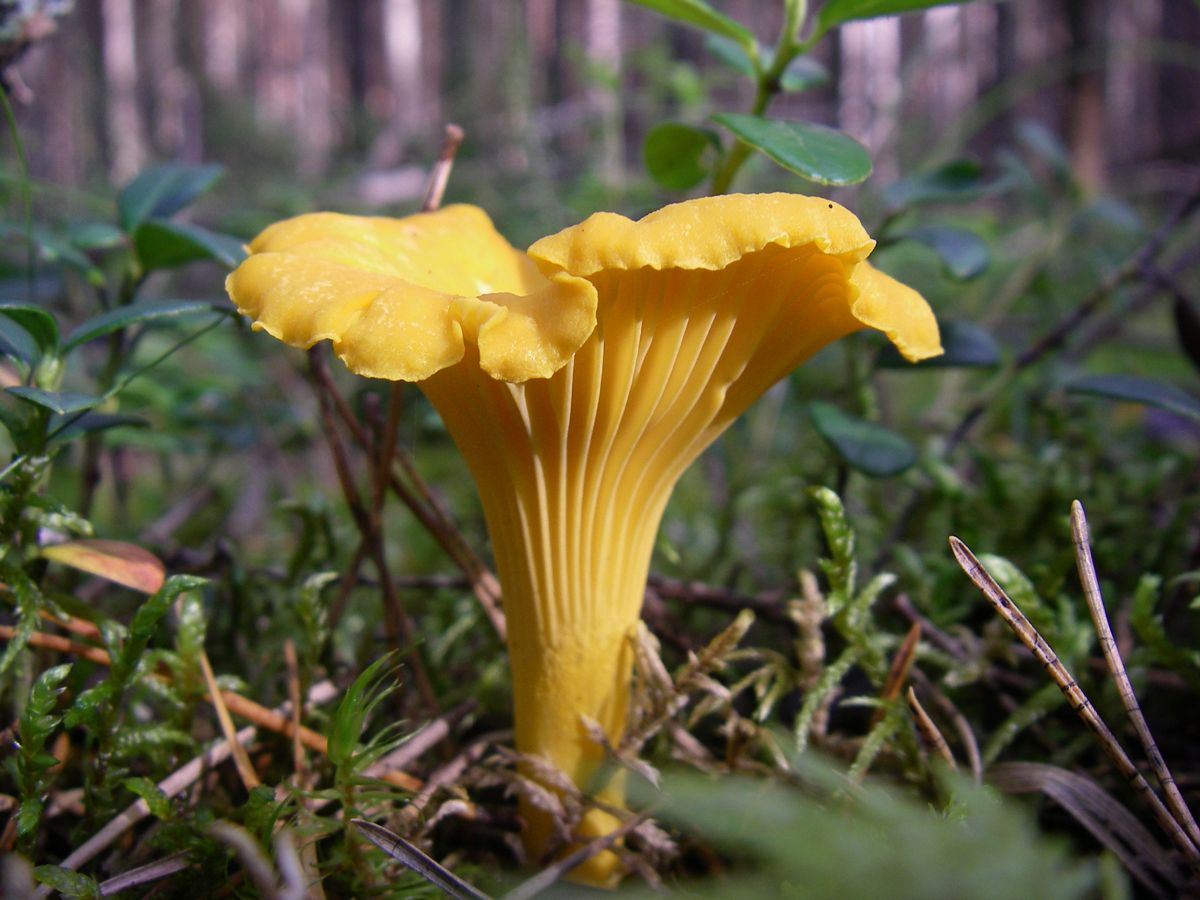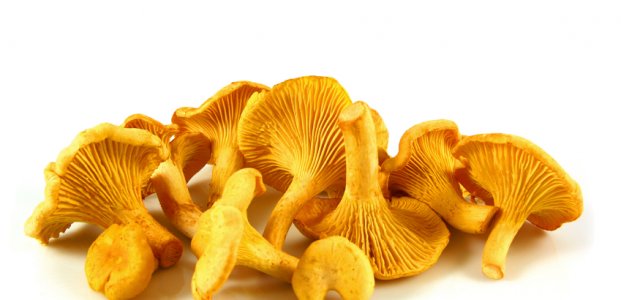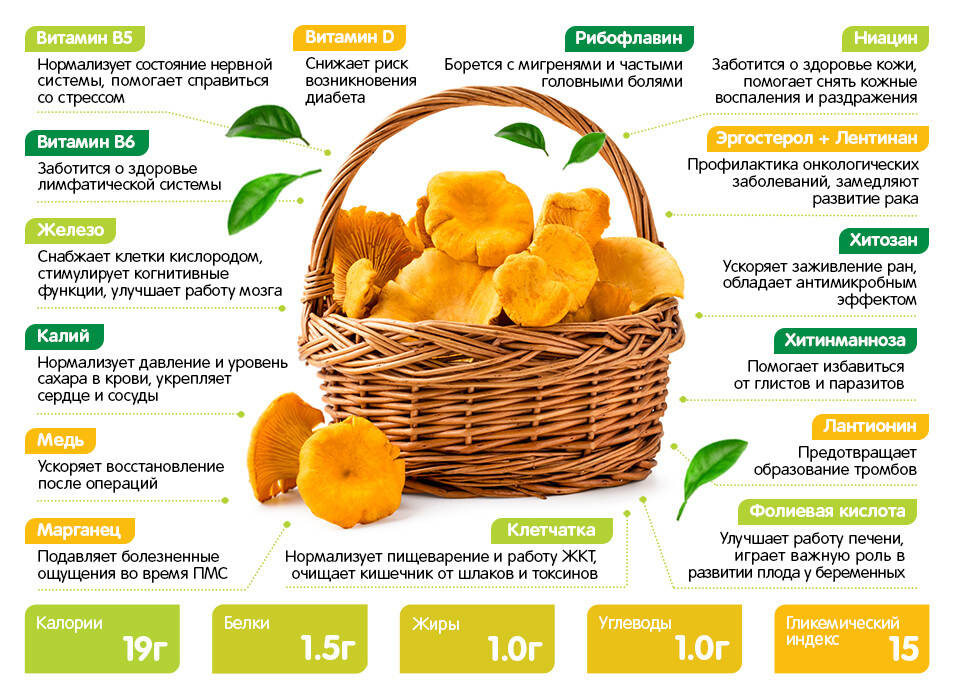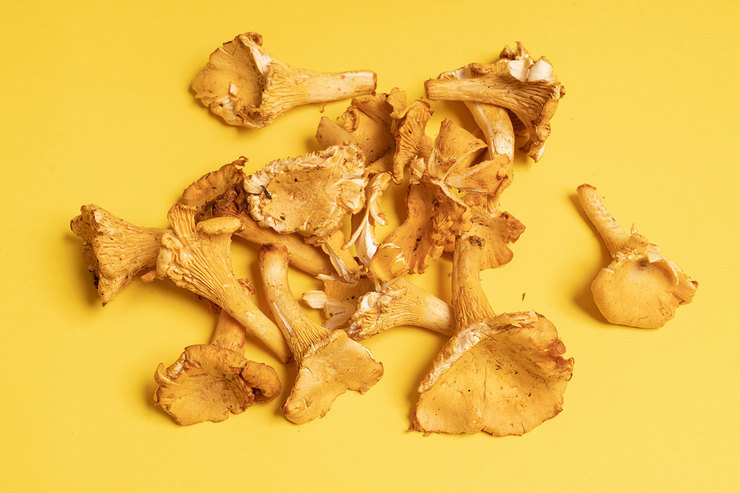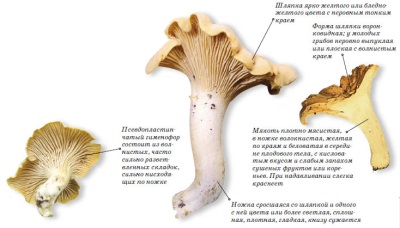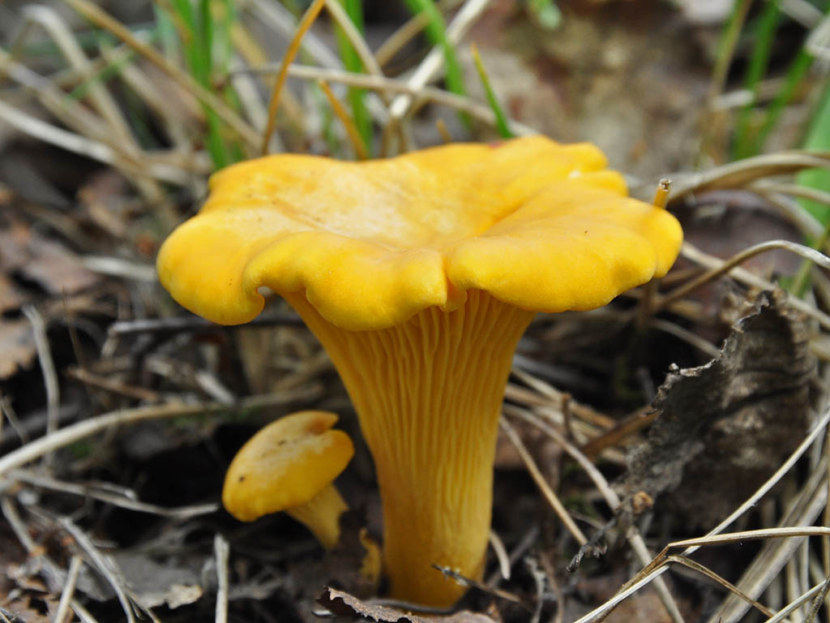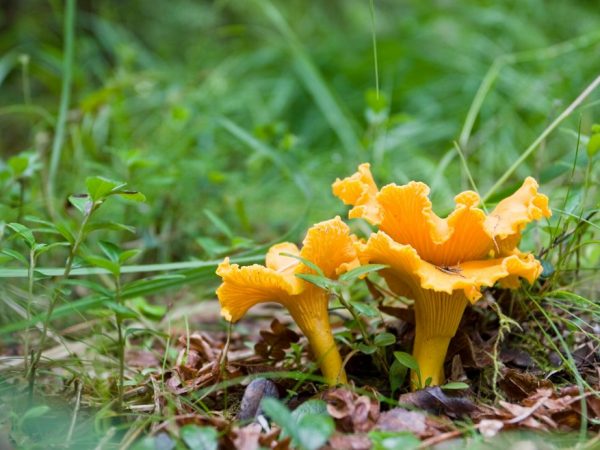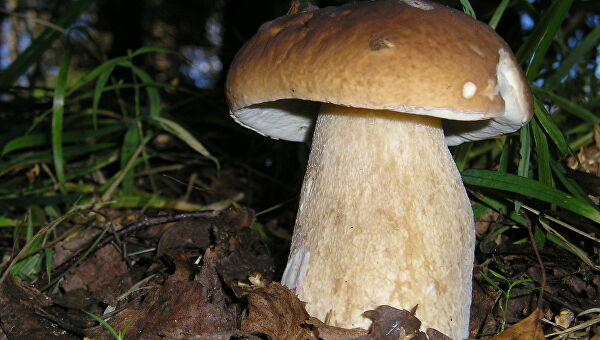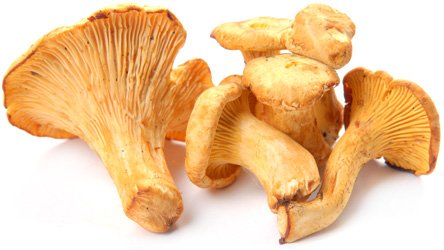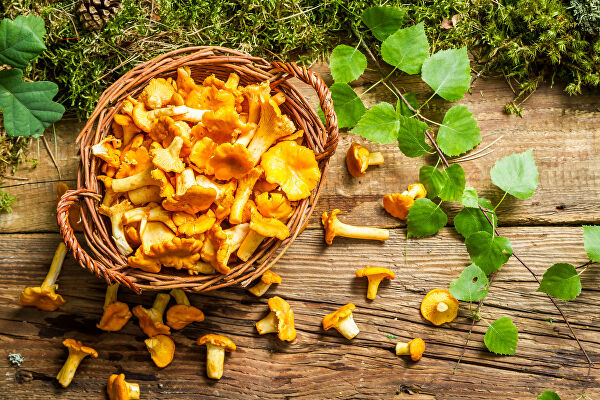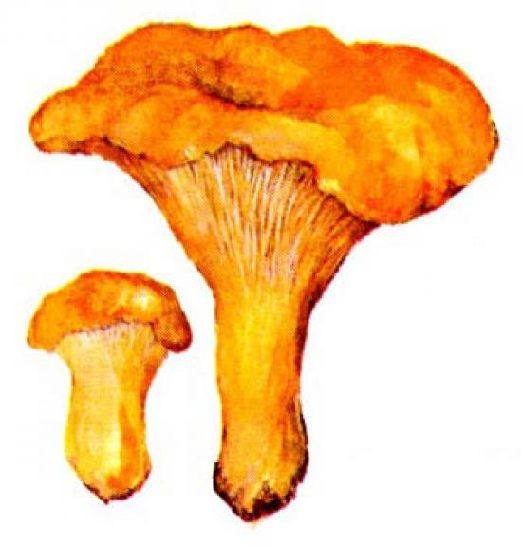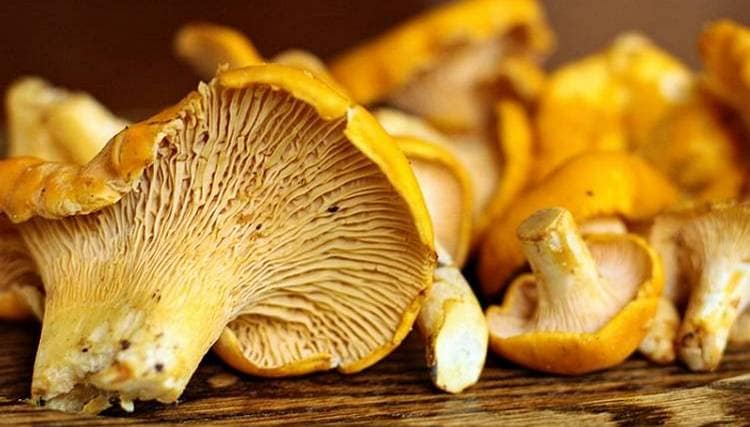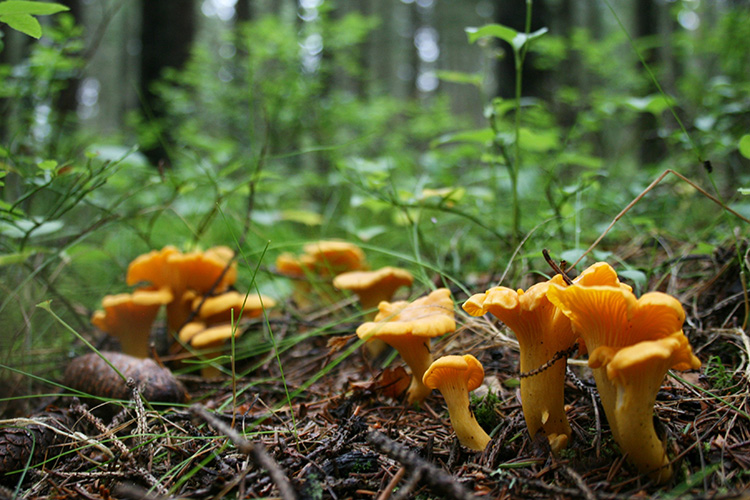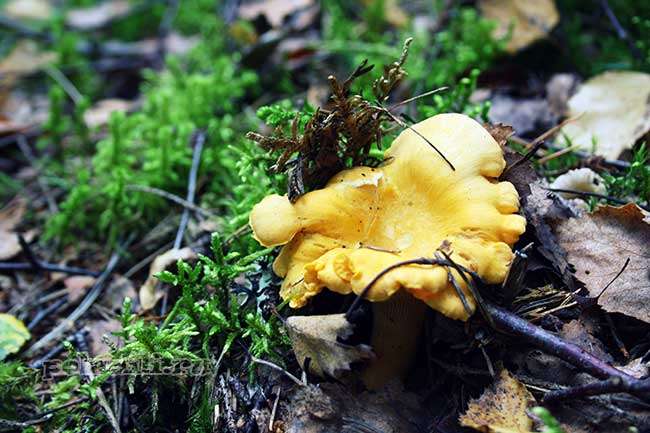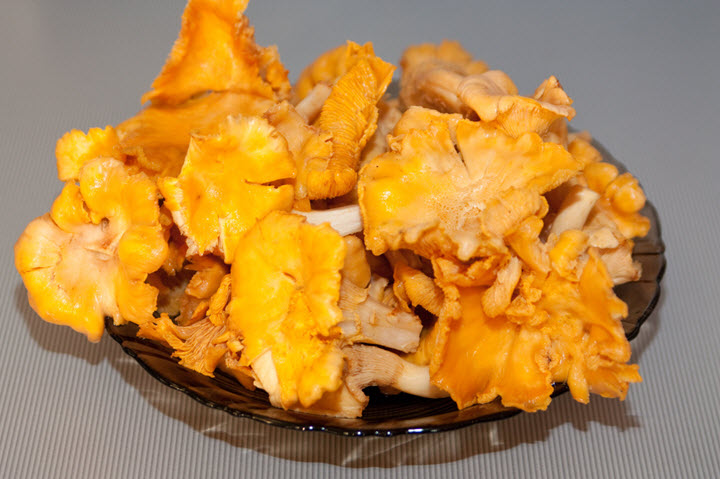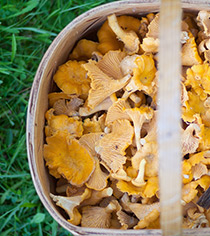Ways to dry chanterelles at home
It's time to figure out how best to dry chanterelles at home. Three methods are actively practiced. They differ in duration. At the exit, almost the same workpieces are obtained.
Classic sun drying
The old method. In time, the process will take from a week to 12 days. A sunny location is required. It is allowed to leave under a canopy.
Instructions:
- Arrange the mushrooms on nets, grates. Large specimens are allowed to be cut lengthwise.
- Place in a suitable place.
- Turn over to the other side periodically.
You can string chanterelles on a thread for drying, as they did in the old days. Mushroom "beads" look interesting in kitchen decor
Just pay attention to strength
Harvesting mushrooms in the oven
It is important not to overexpose, monitor the temperature. We recommend laying parchment
Then nothing will stick.
Instructions:
- Arrange the mushrooms in one layer.
- Cook for 2 hours at 60 degrees with the door slightly open.
- Then lower the temperature to 40 degrees, dry it.
Do not pack immediately - leave it in a dry place for a day. After that, you need to check the workpiece. It should bend easily, take the shape of an arc. Cracks, the mushroom breaks only with strong compression.
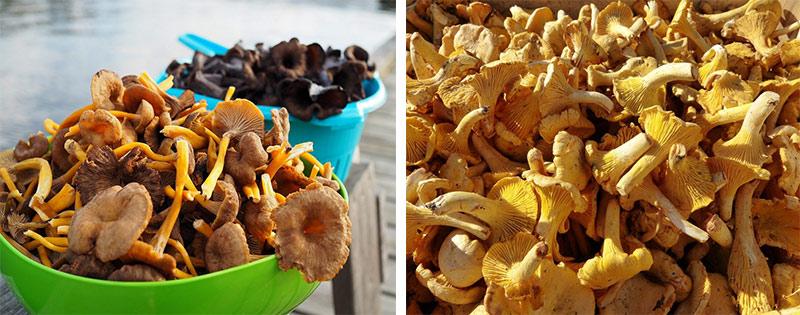 Features of harvesting chanterelles for the winter
Features of harvesting chanterelles for the winter
Fast drying in the microwave
Option for small quantities only. It has many disadvantages - high energy costs, overheating destroys nutrients. The essence of the method is simple - put on a plate, put in the microwave for 20 minutes. Remove every 5 minutes, ventilate.
Chanterelles from an electric dryer
Perfect chanterelles are produced in the electric dryer
The product prepares relatively quickly and does not require close attention. Dried mushrooms remain clean, dust, dirt does not settle
Instructions:
- Arrange the chanterelles on special trays.
- Turn on heating 50-55 degrees.
- Leave on for 14-18 hours.
For uniform airflow, we periodically change the location of the tiers in the dryer. We recommend sometimes turning the mushrooms over to the other side.
Fancy Refrigeration Drying Method
A fun way to dry chanterelles. It is necessary to spread the paper, lay out the chopped mushrooms, leave for a couple of weeks. The effectiveness of the method directly depends on the humidity inside the chamber.
Beneficial features
Many components in the chanterelle composition endow these mushrooms with many unique beneficial properties:
The quinomannose polysaccharide is capable of destroying not only adult helminths, but also their numerous clutches. It acts by introducing into the mucous membrane and blocking the nerve endings of parasites. At the same time, the polysaccharide does not have a toxic effect on the human body. It is worth noting that the quinomannose polysaccharide is present in large quantities in the raw product, but is destroyed by salting and the most gentle heat treatment. Unfortunately, this substance does not stand up to freezing either. Therefore, they learned to extract it from the mushroom and sell it in the form of capsules.

- Ergosterol is a precursor of vitamin D, which enters the human body with food or is synthesized in the skin layers under the influence of sunlight. The plant product ergosterol is not synthesized in animal cells. It is considered an important regulator of calcium and phosphorus levels, is responsible for the balance of trace elements, the concentration of electrolytes in the blood. Participates in the maintenance of tissue mineral density and prevents the onset and development of osteoporosis, promotes the absorption of calcium and phosphorus.
- It should be noted that the concentration of vitamin A in orange chanterelles is higher than in pumpkin or carrots. It holds the record for the concentration of manganese and beta-carotene among mushrooms, which actually colors it orange.
Due to the rich composition of the components, chanterelles have an effect:
- antiviral;
- antibacterial;
- anthelmintic;
- immunostimulating;
- fortifying;
- antineoplastic;
- accelerating metabolism.
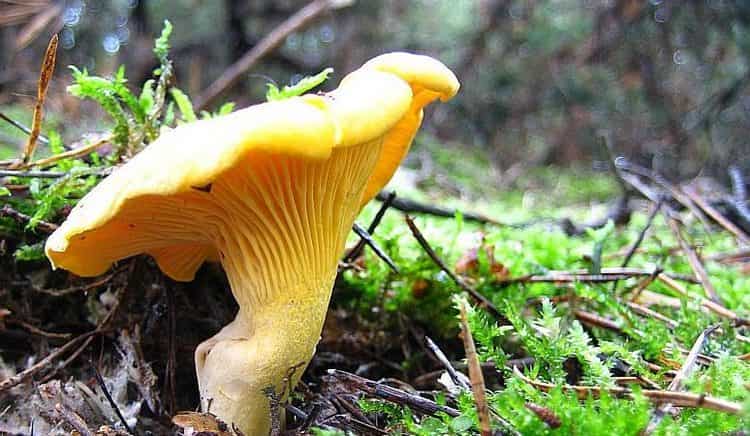
At what age can chanterelles be given to children
Children don't always like mushrooms.
But they will certainly attract attention with their striking appearance. And then the question arises: to give or not to give? Pediatricians do not recommend introducing mushrooms into the diet of a child under three, or even up to six years.
Some mothers decide to feed their baby at three years old, and someone even at seven forbids taking pickled mushrooms. From what age chanterelles can be given to children, no one says unequivocally. The child's body is not ready for such heavy food. And if something happens, he will endure poisoning worse than an adult. Therefore, the later the child tries them, the better for him and the parents. You should not rush, and you will always have time to try mushroom soup.
A little about the beneficial properties of chanterelles
Chanterelles boast a large amount of vitamins and special trace elements, many of which are indispensable for the prevention of a number of eye pathologies. Unique mushrooms are excellent helpers in getting rid of a problematic ailment called “night blindness”. Read more: Mountain honey: useful properties, contraindications, benefits and harms.
Due to the presence of some components present in this product, the hydration of the eyes is improved, which is important for the normal condition of the eyes. The body better resists infectious diseases
Chanterelles are prized for their incredible ability to avoid the accumulation of radioactive elements in their composition. On the contrary, thanks to these fungi, radionuclides are actively removed from the human body. Due to its low calorie content, this product is often found in various diets. The protein noted in chanterelles is appreciated by vegetarians and people who have excluded meat products from their diet.
How useful chanterelles are can be judged by their rich composition.
- The presence of such a component as hinomannose can explain the fact that chanterelles never come with a wormhole. Pests avoid them. But this substance is easily destroyed as a result of heat treatment over 60 degrees. Quinomannose is a polysaccharide capable of destroying the eggs of many parasites and their adult representatives. This can explain why chanterelles are found in a large number of products used to get rid of worms.
- The composition of chanterelles includes Ergosterol, the benefits of which will be appreciated by patients suffering from kidney pathologies.
- Vitamin C, which is present in this product, has a positive effect on the human immune system, is a participant in carbohydrate metabolism.
- Vitamin B6, pyridoxine contribute to the formation of hemoglobin, histamine and protein. Thanks to this, the content of cholesterol in the blood decreases, fats are better absorbed. The role of pyridoxine is to prevent the development of skin pathologies. In addition, this component acts as a diuretic.
- Niacin is an important metabolic component that helps break down and digest food in the stomach. It is indispensable for lowering cholesterol and promoting joint mobility.
- Folic acid, vitamin B - participants in the processes of hematopoiesis, are responsible for the formation of red blood cells. If there is little of such a component in the human body, then anemia develops.
- Thanks to beta-carotene, the precursor of vitamin A, immunity improves, the body is better able to withstand the negative factors of the surrounding world.
- The content of riboflavin, vitamin B2, is difficult to overestimate. An irreplaceable component is very important for the organization of the productive activity of the heart and blood vessels, metabolic processes. The reserves of this substance are referred to as quickly consumed. Chanterelles are one of the ways to replenish a lost component.
Chanterelles can be used to prepare compositions that will become excellent helpers in the fight against a number of pathologies - diseases of the cardiovascular system and pancreas, psoriasis, tuberculosis, sore throat, inflammatory processes, boils.
Important! The benefits of chanterelles can only be talked about if the preparation of the product was carried out in compliance with the necessary rules and regulations
Chanterelles in cosmetology

Few have heard of cosmetic masks made from chanterelles, although in fact they are very useful for the skin and can easily compete with expensive creams purchased in the salon. Masks with this natural component are aimed at softening and moisturizing the skin, can make the complexion more even, giving it a bronze tone.
Compositions containing chanterelles have a tonic effect, are involved in the process of cell renewal. By exerting a normalizing effect on the secretion of sebum, it is possible to prevent the occurrence of acne.
If masks with a "ginger product" are used regularly, then you can count on the effect of tightening the skin, narrowing the pores.
Among the most popular and effective recipes for masks from this mushroom for various skin types are the following:
- For dry skin. The composition is prepared from chanterelles, taken in an amount of 3 pieces, which crumble finely, and diluted with 1 tbsp. a spoonful of sour cream. The thoroughly mixed composition is distributed over the face area.
- For tired skin.To restore the skin vitality and healthy glow, you need to prepare a mixture consisting of 1 tablespoon of oatmeal, which are pre-crushed, the same amount of sour cream, 2 tablespoons. tablespoons of grated mushrooms and 1/3 cup of strong green tea leaves.
- For pale. To prepare the composition, you need 2 tbsp. tablespoons of chanterelles grind from 1 table. a spoonful of cottage cheese and the same amount of carrot juice.
- For the aging. Preparation of the mask comes down to grinding 3 chanterelles in a blender.
- For oily skin. Chopped mushrooms in the amount of 2 tablespoons. spoons connect to 1 table. a spoonful of powdered green tea and 3 tablespoons. spoons of kefir.
Any of these masks should be applied to previously cleansed skin and left on for 20 minutes. After the expiration of time, the composition must be removed with a cotton pad, the remains are washed off with warm water. If after removing the mask there is a feeling of tight skin, then it is recommended to apply a moisturizer of light texture. It is enough to do masks a couple of times every 7 days.
Important! To prevent the development of negative consequences, a small test should be performed before using the mask. A small amount of the composition is applied to the elbow area
If no reaction occurs, then the mixture can be safely used.
The beneficial and medicinal properties of chanterelles are successfully used in modern traditional and folk medicine. However, it must be remembered that in some cases a unique product can be harmful.
Following certain recommendations will help you avoid undesirable consequences and enjoy the positive effect of using a unique product.
Harmful properties
It is worth remembering that chanterelles, like other mushrooms, actively absorb heavy metals, therefore, it is better to collect mushrooms far from roads and industrial facilities. The benefits and harms of chanterelles are not at all the same. These mushrooms have much more useful properties, but harm is possible only under certain conditions. We advise you to adhere to the following recommendations so that the healing qualities of chanterelle mushrooms do not turn into harm:
- Do not pick mushrooms near roads, railways and industrial sites.
- False chanterelles are quite common in our forests - they are dangerous poisonous plants.
- At room temperature, the plant quickly deteriorates, and harmful bacteria may multiply rapidly. To avoid this, cook the mushrooms fresh as soon as possible.
Chanterelles have their own contraindications for people with ailments of the digestive system, gastrointestinal tract, ulcers, gastritis. Doctors do not recommend eating chanterelles before bedtime, children under three years old, pregnant and lactating mothers. Of course, allergic reactions or reactions of individual intolerance to some components are possible. However, such cases with chanterelles are extremely rare.
How to cook profitably
Chanterelles do not retain their useful properties well, they are easily lost when salted, boiled or frozen. It will be possible to preserve the healing qualities of the plant only for a short time. In the national economy, chanterelles are often dried, experts say that after drying, a large number of useful elements still remain in the mushrooms.
Frozen chanterelles, although not so healthy, will retain their taste and will be as fresh even in late winter. If you want to preserve both the taste and benefits of chanterelle mushrooms, then they need to be dried. We propose to consider in more detail the methods of cooking dried chanterelles.
Dried Treasure
In order to preserve the healing properties of chanterelles, you need to take the drying process seriously. First you need to prepare the mushrooms: you need to clean the chanterelles from contamination without water or with a minimum amount of it; whole and strong plants are chosen for drying. There are several methods for drying red mushrooms:
- Classic - drying on a thread over a stove or in the sun.
- In the oven.
- In an electric dryer.
- In the microwave.
Of course, the most correct way is the classic method of drying in the sun. However, if climatic conditions permit, after the rain, wet mushrooms can be simply thrown out - they will be spoiled.
For drying over the stove, the mushrooms are strung on a thick thread and hung over the stove (at a distance of about 50 cm). From time to time you need to turn on the gas, you can independently adjust the drying speed, but you should not rush. The drying process with this method can last from 1 to 3 days.
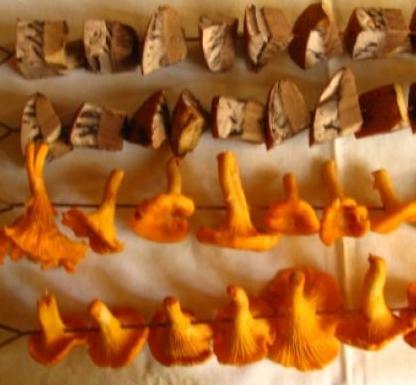
Please leave your recipes for cooking chanterelles
Perhaps you have the secret way to preserve the beneficial properties of mushrooms! Thank you for the attention:)
How to collect and store chanterelles correctly?
Chanterelle hunting season begins in July - exactly in the middle of summer. These mushrooms usually grow in large groups in the shade of trees of mixed, coniferous and birch forests and in clearings.
Silent hunt
You can go to the forest for chanterelles from mid-June to early October. They prefer rainy summers, especially after thunderstorm showers. You can search for them everywhere. Chanterelles do not like loneliness, they gather in groups in the meadows. They often hide under moss and foliage.
In nature, there are several types of chanterelles: real, false, tubular, yellowing, grayish. In medicines and prophylactic agents, only the real chanterelle is used. Other species have not yet been studied enough to give specific recommendations for their use.
Signs of real chanterelles: the cap is concave, bright yellow, with wavy edges. The leg is dense, not loose, a little darker than the cap. The pulp is yellow-white, firm, not damaged by worms or insects. Smells delicious like nuts or even fruit.
If you notice that a small family of chanterelles is sitting on a fallen tree - be careful! After all, real mushrooms would prefer a mossy stump.
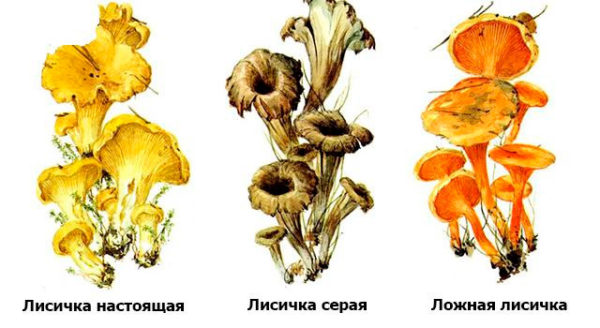 If you know the signs, you will not confuse real mushrooms with doubles.
If you know the signs, you will not confuse real mushrooms with doubles.
Often the yellowish blackberry is mistaken for chanterelles. Their color is similar, but papillae in the form of needles grow on the bottom of the cap. Another double is the olive omphalot (Omphalotus olearius). This mushroom is deadly poisonous, but it grows only in the subtropics and not in the soil, but on wood dust.
False chanterelles grow on rotten trees and forest floor. The color of such mushrooms is more intense (with an orange-brown tint), the cap is neat, regular, round, and even. The edges of the cap are lighter than itself.
Since they absorb compounds of heavy metals, chanterelles should be collected in ecologically clean areas: as far as possible from the industrial zone and the roadway.
If you don't know mushrooms well, go to the forest only with an experienced mushroom picker.
Video: collecting chanterelles in the forest
Storage
When freezing, cooking, frying, salting, the medicinal properties of chanterelles are destroyed. Therefore, for treatment, it is better to use them fresh or dried.
For drying, the mushrooms must be prepared in advance. To do this, they are freed from dirt with a brush. In no case do they wash. After that, they are strung on threads and hung in the attic. You can also dry it in the oven. Readiness can be judged when the mushrooms break when pressed.
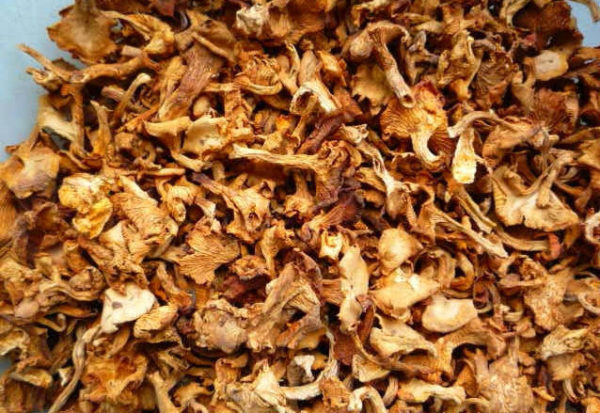 When drying in the oven, the temperature should not exceed forty-five degrees, otherwise the nutrients of the chanterelles will begin to collapse
When drying in the oven, the temperature should not exceed forty-five degrees, otherwise the nutrients of the chanterelles will begin to collapse
Convenient to store in powder form, preferably in a glass jar. To avoid moldiness, before placing dry mushrooms or powder inside, pour a little alcohol on the bottom and set it on fire. So there will be no oxygen left inside.
If desired, add dried parsley, dill, celery and other seasonings to the chanterelle powder.
The harvested mushrooms can be stored in the refrigerator for two to seven days, but are best cooked fresh.
Description and composition
Chanterelles can be attributed to cap mushrooms. In appearance, they are very similar to the representatives of this group, although their cap and leg are a single whole (there is no clear border). The diameter of the cap is 2.5-5 centimeters. It can be convex, flat or concave, leucoid. It depends on age: young mushrooms have a convex cap, but over time it becomes more and more like a funnel. In the outlines of the hat, asymmetry is visible. The upper surface is smooth. The hat rests on a short stem, 2-4 cm long. Its surface is also smooth and complete.
Learn where they grow, how to freeze and pickle chanterelles.
The mushroom pulp is dense, resembling rubber in consistency. Usually white, sometimes with a yellowish tinge. Has a pleasant taste and aroma. The color of the mushroom is yellow. It grows very actively at high humidity.
Did you know? If you press on the flesh of the chanterelle, it will take on a pinkish tint.
The following useful substances were found in chanterelles (per 100 g of product):
Macronutrients:
- potassium - 450 mg;
- calcium - 4 mg;
- magnesium - 7 mg;
- sodium - 3 mg;
- phosphorus - 44 mg;
- sulfur - 40 mg;
- chlorine - 24 mg.
Trace elements:
- iron - 0.7 mg;
- cobalt - 4 mcg;
- manganese - 0.41 mg;
- copper - 290 mcg;
- fluorine - 55 mcg;
- zinc - 0.26 mg.
Not only chanterelles are used in folk medicine, learn about recipes for using porcini mushrooms, milk mushrooms, champignons, butter mushrooms, fly agarics, shiitake, reishi, veselocks, tinder fungus, chaga.
- vitamin A, RE - 142 mcg;
- vitamin B1 - 0.01 mg;
- vitamin B2 - 0.35 mg;
- vitamin C - 34 mg;
- vitamin E - 0.5 mg;
- niacin - 4.9 mg;
- vitamins PP, NE - 5 mg.
Other substances:
- amino acids;
- fatty acid;
- mushroom antibiotics;
- chinomannose (chitinmannose);
- ergosterol (provitamin D2);
- trametonolinic acid;
- beta glucans;
- mono - and disaccharides;
- polysaccharide K-10.
On a quiet hunt, false boletus, pigs, inedible mushrooms, pale toadstools, satanic mushrooms, false boletus deserve special attention - they should be avoided. Nutritional value of 100 g of product:
- proteins - 1.46 g;
- fats - 1.33 g;
- carbohydrates - 1.26 g;
- dietary fiber - 7.30 g;
- water - 88.5 g;
- ash - 1 g;
- organic acids - 1.5 g
Calorie content:
| Dish | Kilocalories per 100 g |
| Dried | 253,03 |
| Baked | 73,67 |
| Stewed | 37,45 |
| Boiled | 25,27 |
| Pickled | 41,02 |
| Fried | 34,52 |
| Fresh | 19,76 |
| Frozen | 17,02 |
| Canned | 19,54 |
Did you know? Every year around 200 thousand tons of chanterelles are harvested in the world. A kilogram of these mushrooms on the international market costs 8-12 dollars.
How to prepare chanterelles?
Having collected mushrooms in the forest, you need to immediately clean them of excess debris and dirt
It is important to get rid of spoiled and wrinkled copies.Fresh chanterelles can be stored for 1 day indoors and 5 days in the cold

Properly harvested mushrooms help to remove almost all types of worms from the body. Only fresh and dried chanterelles have healing properties. Vinegar, brines, heat treatment inevitably spoil their healing potential.
Mushroom treatment is a long-term procedure. A lot of patience will be required from the patient, since the result from alternative therapy is achieved by the systematic consumption of chanterelles without interrupting the treatment course.
There are many recipes for cooking mushrooms, but most often chanterelles are used in freshly picked form. Consider how to treat raw chanterelles and what the reviews will be.
Fresh mushroom recipes.
Chanterelles and porcini mushrooms.
Chanterelle is perhaps the only mushroom of its kind that can be eaten fresh. To enhance the anthelmintic effect, it is recommended to eat chanterelles with porcini mushrooms.
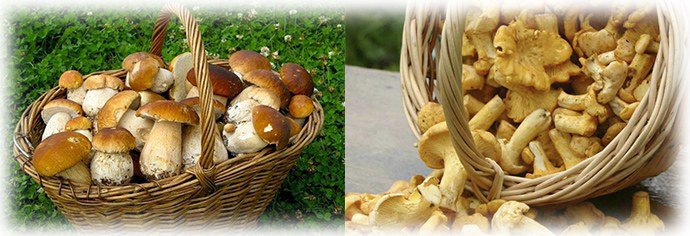
Infusion of chanterelles.
Grind the raw mushrooms picked in the next few hours into a gruel and boil them with a glass of hot water (no more than 60 ° C). Insist the remedy for an hour. Drink the obtained mushroom infusion on an empty stomach along with the cake. The course is 30 days. This recipe is especially recommended for children.

Chanterelles and honey.
Finely chop a handful of raw chanterelles, boil them with a glass of boiling water, after cooling, mix 2 tbsp. spoons of honey. Take the remedy twice a day. The course is 2 months.

Tincture.
Fresh mushroom tincture is no less effective. To do this, you need to clear from forest mud 200 gr. freshly picked chanterelles, cut them into pieces and pour 500 ml. vodka. Keep the tincture in the refrigerator for 2 weeks, shaking occasionally. Take orally 1 teaspoon 1 time per day on an empty stomach. The course is 1 month.

To prepare a medicinal tincture, you will need a handful of freshly picked chanterelles, 1 tbsp. a spoonful of tansy herb, 2 cloves of garlic, pumpkin seeds and a small amount of lingonberries. Pour all the ingredients with 0.5 liters. vodka and leave in a dark place for 7 days.
Before taking this tincture, you should consult your doctor. Development of undesirable effects is possible.
Dried mushroom recipes
Mushroom powder.
To prepare medicinal preparations based on dried mushrooms, you must first grind them with a coffee grinder. The powder of chanterelles prepared in this way must be taken orally 1 teaspoon per day or in the form of spices for cooked food.


Mushroom infusion is consumed regularly, in the evening hours before bedtime. The course is 20 days. It is recommended to drink the mushroom sediment without fail.
Infusion using herbs.
You can combine the medicinal properties of mushroom powder with the properties of herbal infusions. For this purpose, an infusion is prepared from herbs such as mint, wormwood, oak bark, tansy - you can use all the herbs at once or some of them.

At 1 st. a spoonful of herbal collection will need a glass of boiling water. Add mushroom powder to the prepared infusion, and use the product inside.
In the form of dried mushroom powder, chanterelles retain all their medicinal properties as much as possible.
Tincture.
An effective tincture can also be prepared from chanterelle powder. 10 gr. pour 150 ml of mushroom powder. vodka or rubbing alcohol, and leave for 10 days. From time to time, the future tincture needs to be shaken. The finished product is taken 2 teaspoons before bedtime. The course is 2 months.

How to use chanterelle tincture, we will additionally consider in the table.
Application in traditional medicine
Alcohol tincture of chanterelles has found extensive use in folk medicine. It helps with cancer, diabetes, as well as diseases of the pancreas and liver. With the help of a healing liquid, parasites can be removed from the body. The method of preparation, as well as the characteristics of the administration, depend on the area of application of the natural medicine.
A little about the use of mushroom tincture:
With oncology
Unlike most drugs, quinomannosis, which is part of chanterelles, has a negative effect not only on tissues and organs affected by cancer, but also on spreading metastases. The product is prepared as follows: 250 grams of fresh mushrooms is washed, peeled and cut into pieces, then filled with 750 grams of high-quality vodka. Everything is mixed and infused in the refrigerator for 2 weeks. You need to drink the medicine 1 teaspoon three times a day on an empty stomach, half an hour before meals. The course of treatment is 1 month.
Instead of fresh raw materials, it is permissible to use dried mushrooms. For 0.75 liters of alcohol, 45 grams of dry chanterelles will be needed.
In no case should you quit or interrupt therapy, feeling an improvement in your well-being, as the disease may return.
With diabetes mellitus
Alcoholic mushroom tincture helps to lower blood glucose levels and helps to optimize the functioning of the pancreas. It is prepared as follows: 1 tablespoon of dried mushrooms, ground into powder, is poured with an incomplete glass of vodka (200 grams), everything is stirred and infused in the cold for 1.5 weeks. You can also make a medicine from 200 grams of fresh mushrooms and 0.5 liters of vodka, infused for 21 days in the cold. Both funds are taken 1 teaspoon twice a day (morning and evening), the agent is drunk on an empty stomach, it should be diluted in 1 glass of water. The course of treatment is 2 months.
From parasites
Mushroom tincture is one of the oldest antiparasitic agents. With its help, they got rid of worms in ancient China.
To make the product, you need 1 tablespoon of dried mushroom powder, pour 1 glass of vodka, shake and leave to infuse for 2 weeks at room temperature. It is advisable to shake the mixture daily. She drinks 2 teaspoons before bedtime. You need to take on an empty stomach for 20 days.
The same remedy can be drunk to cleanse the liver, however, the duration of the course is 14 days. At the same time, slags, toxins and radionuclides are removed from the body.
For diseases of the liver and pancreas
Chanterelle tincture helps with cirrhosis, hepatitis and other liver diseases, as well as pathologies of the pancreas. The simplest and most effective recipe for preparing the product is as follows: 1 tablespoon of dried chanterelle powder is poured with 200 grams of vodka, shaken and infused for 10 days in the cold. Shake the container with the medicine daily.
To improve the work of the pancreas, you should drink 1 teaspoon of alcoholic liquid on an empty stomach within 3 months. With hepatitis, the medicine is used in the same dose, but twice a day (morning and evening) for 4 months.
A two-week course of taking this remedy 2 times a day, 1 teaspoonful, will help cleanse the liver. It is recommended after serious illnesses, during which intensive drug treatment was carried out.
What do chanterelles look like and where do they grow?
Everyone knows what they look like. They do not need special introduction. A beautiful ginger mushroom can be seen even in a textbook for elementary grades. People who are completely unfamiliar with mushrooms can confuse chanterelle with mushroom or false. To prevent this from happening, you need to learn more about the distinctive features.
In order not to grab the saffron milk cap, you need to look at the edges and color of the cap, in the chanterelle they are curved and curly, and the color is much lighter than red. The yellow beauty grows throughout Russia and in the forests of Europe. There are especially many mushrooms in coniferous forests after rain. The hat of the still young mushroom is concave, and the edges are bent down. The old one has a lot of hairs around the edges
Attention is also paid to the records. They can match the thickness of a sheet of paper
The rows are close, and the color of each of them is the same. The leg is up to 5 centimeters in length, up to 1 in thickness, it becomes wider towards the cap.

Botanical description of chanterelles
Chanterelles are called Cantharellus in Latin and represent a section of Basidiomycetes, a class of Agaricomycetes of the Chanterelle family.They look quite specific and therefore it is difficult to confuse this variety with any other. The only exception is false chanterelles.
The chanterelles visually resemble the caps of pedunculated mushrooms, however, both of their parts are, as it were, fused together. The body of the mushrooms is bright, usually colored yellow-orange or brown-orange. The head of a medium-sized mushroom is about 8 centimeters in diameter, although specimens with a diameter of almost 14 centimeters come across. The top is like a funnel, they say that it is a "concave umbrella".
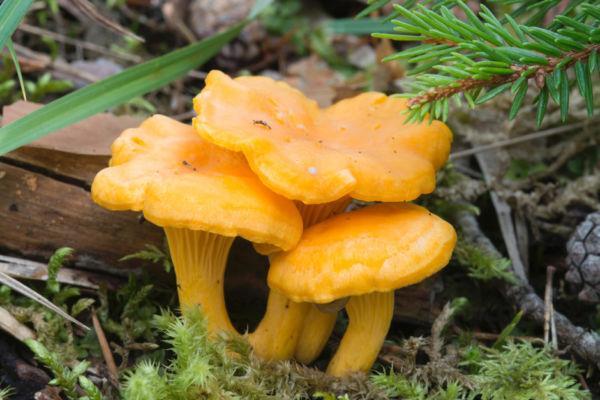
The mushroom pulp is quite dense, fleshy, there are hard fibers at the base of the leg. The chanterelles taste sourish, barely perceptibly smell of dried fruit. If you press down on their surface, the pressure point becomes reddish.
The hymenophore has a folded, pseudoplastic surface in the form of waves falling along its stem. The spore powder in representatives of the chanterelle family is yellow, finely dispersed.
Chanterelles can be found in the forest from early summer to mid-autumn. Most often, mushrooms grow in damp, damp areas, in tall grass, among moss, or under a pile of fallen leaves. Basically, they grow in large groups. A special growth spurt in chanterelles (and many other mushroom varieties) is observed after the rains.
Botany knows about 60 varieties of chanterelles, and most of them are suitable for consumption. Representatives of the genus omphalot, visually similar to chanterelles, are considered poisonous twins of chanterelles.
For phytotherapeutic purposes, the most commonly used chanterelle, also known as Cantharellus cibarius, cockerel or true chanterelle. Less commonly used chanterelle gray, cinnabar red, velvety, faceted, and also yellowing chanterelle.
2 mushroom varieties are considered to be false chanterelles:
- Orange talker
- Omphalot olive

The first species is not edible, and the second is poisonous. The middle of the cap of a non-edible chanterelle is, as a rule, slightly darker colored than the edges, while the real representative of the chanterelle family is monochromatic. In false mushrooms, the edges are usually even, and in a real chanterelle, they are torn. The leg of the false chanterelle is thin, while that of the real one is thick and dense. Poisonous mushrooms can be wormy, but worms are never found in real chanterelles. Non-edible mushrooms grow mainly one at a time, but edible mushrooms grow in groups.
Application in traditional medicine
In any phyto-pharmacy, you can easily find and purchase medicinal preparations based on the mushroom, but you can also make your own preparations and preparations for them from red healers collected in local forests.
Chanterelle tincture
Due to the fact that the main nutrients in chanterelles die during heat treatment, tincture is often used for medicinal purposes. With regular use, the effect can be seen within a month.

Chanterelle tincture
The tincture is made with vodka. For 250 ml of liquid, take two tablespoons of fresh chopped mushrooms or 5 teaspoons of dry powder. Mix the ingredients well and close the bottle. Insist 2 weeks in a dark place. Consume 1 teaspoon within a month before bedtime.
Liver tincture is prepared in slightly different proportions. For 250 ml of vodka, one tablespoon of powder is taken and infused for a week and a half. Take a teaspoon in the morning and evening for 3 or 6 months.
Powder
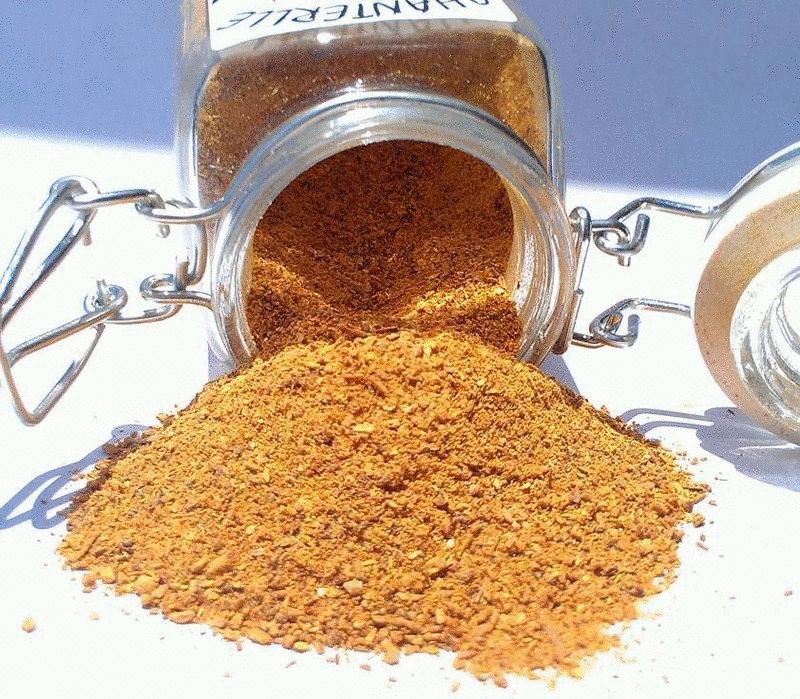
Mushroom powder
Recipe for fighting parasites on water: take a teaspoon of powder for 100 ml of warm water and leave for half an hour. Consume one hour before meals, once a day for 25 days. Stir before use.
Extract
Medicinal chanterelle extract can be purchased at the pharmacy. Home cooked is suitable only for culinary recipes, as it undergoes heat treatment and loses valuable polysaccharides.
To prepare the hood, it is necessary to clean the mushrooms, boil them and grind them dried in a meat grinder or blender.Put the minced meat under a press and mix the squeezed juice with the water remaining after cooking. Simmer the mixture over low heat in half to form a syrup. It can be frozen in portions and used in recipes.
Pharmaceutical companies in Japan and China make preparations based on the extract or extract of the common chanterelle. A new and interesting science has come to us from these countries - fungotherapy. Fungotherapy is a method of treatment with mushrooms, which are included in the composition of medicinal drugs along with medicinal herbs.
Mushrooms are collected, dried, ground into powder, added to decoctions and infusions for treatment:
- pancreas;
- pneumonia;
- hepatitis A;
- diabetes;
- flu, tonsillitis;
- diseases of an inflammatory nature.
Children are not prescribed alcoholic tincture. Instead, it is recommended to make an aqueous infusion: pour 1 teaspoon of mushroom powder in 150 ml of warm water, let it brew for 30 minutes and drink in two doses along with the sediment. After taking it, you can not eat for half an hour.





